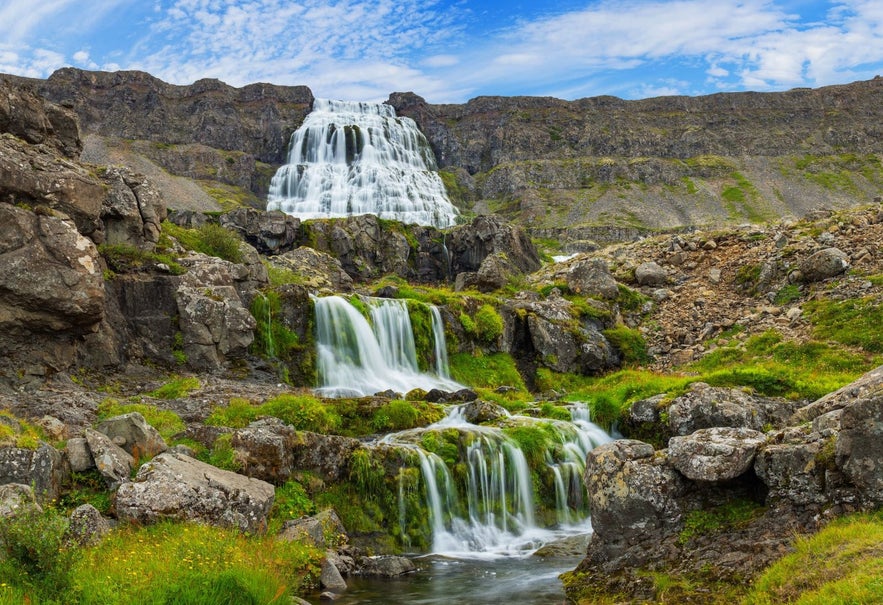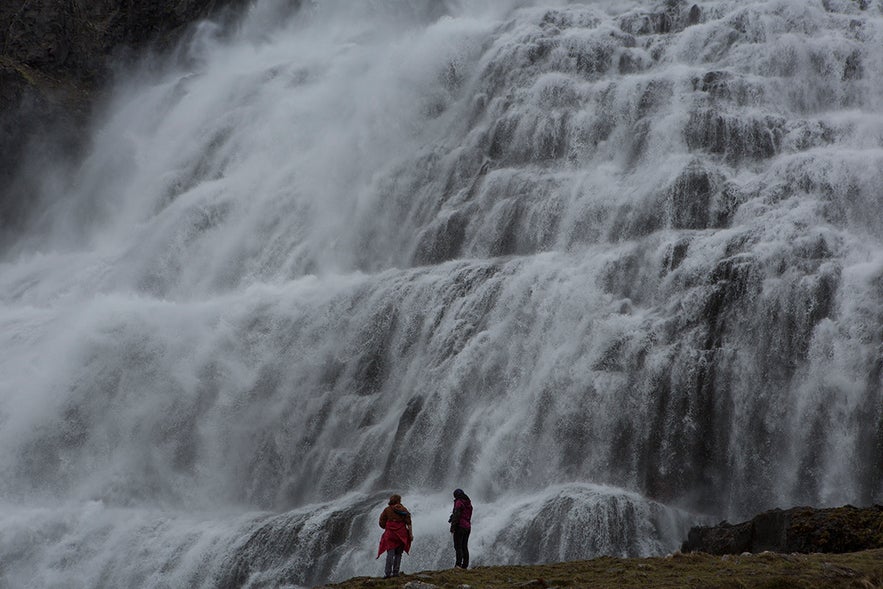
Dynjandi Travel Guide

Explore this region on a Westfjords tour in Iceland.
Dynjandi is particularly beloved by visiting nature enthusiasts and aspiring photographers, who are able to snapshot this fantastic natural feature from a wealth of angles.
Geography
Dynjandi can be found close by to Dynjandisvogur Bay and Arnarfjörður fjord, an area widely famed for its wealth of birdlife, stunning natural vistas and picturesque coastlines.
Colloquially titled ‘the Jewel of the Westfjords’, Dynjandi (otherwise known as Fjallfoss) cascades approximately 100 metres (328 ft) in total, falling in a trapezoidal shape; it is 30 metres (98 feet) wide at the top, 60 metres (196 feet) wide at the bottom.
In the summer, the flow rate of Dynjandi is up to eight cubic meters per second (282 cubic feet), whilst the winter it reduces to as little as one cubic metre per second (35 cubic feet).
Those wishing to view Dynjandi from the top are able to hike nearly 200 metres (656 feet) up the cliffside. As they do, they will pass the seven individual waterfalls that lead to the largest: Hæstahjallafoss, Strompgljúfrafoss (Strompur), Göngumannafoss, Hrísvaðsfoss-Kvíslarfoss, Hundafoss and Bæjarfoss (Sjóarfoss).
In 1996, there was a rocky path built to the top Dynjandi by volunteers, making the hike little more than 15 minutes in total.
Visiting Dynjandi

To travel to the Westfjords, one of your best options would be renting your own vehicle and driving yourself. Dynjandi is approximately 363 kilometers (226 miles) away from Iceland’s capital city, Reykjavík, meaning it will take some commitment to visit.
Alternatively, you could choose to join a guided tour around the Ring Road and the Westfjords, either by bus or Super Jeep, allowing an experienced tour guide to take responsibility for the driving.
It is also possible to fly to an airport in the Westfjords from Reykjavík Domestic Airport.
Though the Westfjords are remote, they have enormous appeal to nature lovers who want to avoid the crowds. Most visitors do not make the effort to travel to them, so the beautiful sites are some of the most unspoiled and peaceful in the country.
Other than Dynjandi are sites such as the Hornstrandir Nature Reserve and the Látrabjarg birdwatching cliffs. The former is the least populated part of the country, with incredible panoramas and a wealth of Arctic Foxes. The latter is the best place to see puffins from land, as they nest in the tens of thousands.
Due to the fact that both species are protected in their respective habitats, they have little fear of people and will let you within mere meters.
Though sparsely populated, there are a few significant towns in the Westfjords. Foremost amongst them is the settlement of Ísafjörður, which is the region’s capital and its center of tourism and trade.
Since 1981, Dynjandi has been considered a National Monument, meaning extra care must be taken not to stray from the specified walking trails. Iceland’s vegetation is incredibly fragile, often taking decades to repair once damaged. Remember, take nothing but photos, leave nothing but footprints.
Attractions Nearby
Popular categories

Download Iceland’s biggest travel marketplace to your phone to manage your entire trip in one place
Scan this QR code with your phone camera and press the link that appears to add Iceland’s biggest travel marketplace into your pocket. Enter your phone number or email address to receive an SMS or email with the download link.


















